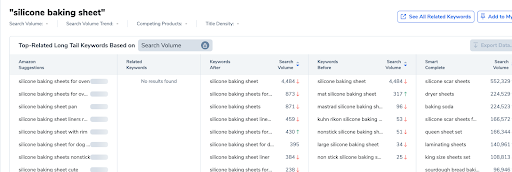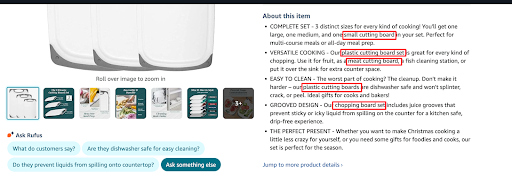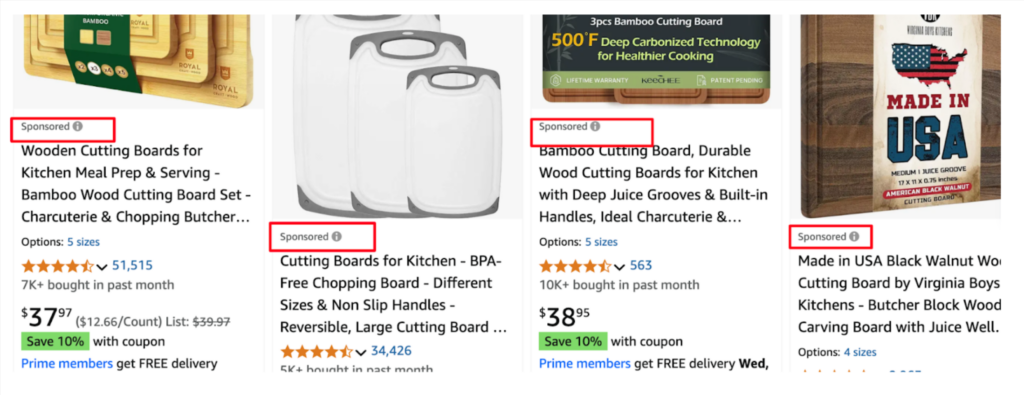
When you write great content, add stunning images, craft A+ Content, share a compelling brand story, optimize pricing, and gather more reviews, your conversion rates improve—and yes, your organic ranking gets a boost too. But let’s be honest, none of that moves the needle quite like using the right keywords. The catch? Simply adding keywords isn’t enough; you need ones that actually rank. And that’s where it gets tricky.
Today, we’re gonna learn what it takes to not just find keywords but to make them work for your Amazon listings. Let’s get started.
1: Let tools like Helium10 do the keyword heavy lifting
If you’re not using keyword research tools like Helium 10, you’re working too hard and getting nowhere. These tools are built to make your life easier by showing you exactly what shoppers are searching for.

- Find ranking opportunities: Use Cerebro to analyze competitor ASINs and find new keywords they rank for but you don’t. Target those gaps to outperform them.
- Pick realistic goals: Focus on long-tail keywords with moderate traffic and low competition. These are easier to rank for, especially for new products.
- Understand the CPR score: Helium 10’s CPR (Cerebro Product Rank) score tells you how many sales are needed in a short time to rank for a specific keyword. Use this to plan targeted PPC campaigns and promotions.
- Track your rankings: Use Keyword Tracker to monitor your performance and adjust if rankings don’t improve.
The goal isn’t to guess your way to the top—it’s to strategically target and dominate keywords that align with your product and niche. If you don’t have time to dive into this yourself, consider investing in Amazon keyword research services to get the data you need without doing all the grunt work.
2: Go long-tail for less drama and more ranking wins
Long-tail keywords are longer, more specific search terms that target niche audiences. For example, instead of “wireless headphones,” a long-tail keyword might be “noise-canceling wireless headphones for office use.” Ranking for these might not bring millions of impressions, but it can drive highly relevant traffic that converts better.

Big sellers often dominate short, high-volume keywords. Long-tail keywords are less crowded, giving smaller sellers a chance to shine. These keywords also match highly specific customer searches, meaning buyers are closer to making a purchase when they use these terms.
How to find and rank for long-tail keywords
- Research niche variations: Use tools like Google’s autocomplete, Amazon’s search bar, or keyword research services to identify detailed, specific phrases your audience uses. For example, typing “yoga mat” might suggest “non-slip yoga mat for hot yoga.”
- Analyze customer reviews: Customers often describe exactly what they’re looking for in reviews. If buyers repeatedly mention “lightweight and portable,” that’s a clue for a long-tail keyword to target.
- Incorporate long-tail keywords naturally: Add these keywords in your product titles, bullet points, and descriptions. For example, instead of saying “lightweight mat,” go with “lightweight, non-slip yoga mat for hot yoga.”
- Run targeted PPC campaigns: Create ad groups focused on one or two long-tail keywords. This helps Amazon’s algorithm associate your product with those terms, boosting both paid and organic rankings.
- Track and refine: Monitor your keyword rankings and adjust based on what’s working. Long-tail keywords often have less data upfront, so tracking performance is key to refining your strategy.
By focusing on long-tail keywords, you’re targeting an audience that knows exactly what they want—and they’re ready to buy. It’s not about casting a wide net; it’s about catching the right fish.
3: Place your keywords where it counts—titles and bullets
It’s not just about having the right keywords—it’s about putting them where they’ll make the most impact. Titles and bullet points are prime real estate on your product listing.

Titles
- Prioritize your main keyword: Your most important keyword should be at the beginning of your title. For example, if your keyword is “non-slip yoga mat,” your title might start with “Non-Slip Yoga Mat for Hot Yoga.” This ensures it’s visible in search results and grabs attention.
- Keep it readable: Don’t keyword-stuff. A title like “Yoga Mat Non-Slip Non-Toxic Hot Yoga Lightweight Durable” is off-putting to shoppers and could hurt your ranking. Balance keywords with a clear, natural flow.
- Highlight key benefits: Combine keywords with key product features or benefits to make the title compelling and informative. For instance, “Non-Slip Yoga Mat for Hot Yoga – Lightweight & Eco-Friendly.”
Bullet points
- Weave in secondary keywords: Use bullet points to target secondary keywords that support your main keyword. If your main keyword is “non-slip yoga mat,” include terms like “hot yoga mat,” “lightweight yoga mat,” or “eco-friendly yoga mat” in different bullets.
- Focus on benefits, not just features: Don’t just say “lightweight design”—expand it to “lightweight design, perfect for carrying to yoga classes.” This approach naturally incorporates keywords while appealing to the customer. Hire Amazon listing optimization services to cleverly incorporate keywords into your bullet points.
- Use formatting smartly: Break text into digestible chunks, and use keywords in the first few words of each bullet. This helps Amazon’s algorithm prioritize those terms.
4: Add remaining keywords in backend search terms
Backend search terms aren’t visible to customers but are crucial for Amazon’s algorithm to index your product for more searches.

- Use every character wisely: Amazon allows 250 bytes (not characters) for backend search terms. Use all of it without repeating keywords already in your title, bullets, or description. This space is for additional keywords that didn’t make it to the visible parts of your listing.
- Include variations and synonyms: Add alternate spellings, regional terms, or synonyms your audience might use.
- Avoid irrelevant keywords: Stay focused on terms directly related to your product. Adding unrelated terms can hurt your conversion rates and confuse Amazon’s algorithm.
- Skip punctuation and fillers: No need for commas, periods, or unnecessary connectors like “and” or “for.” For example: Write: “eco friendly yoga mat lightweight hot yoga mat durable” Avoid: “eco-friendly, yoga mat, for lightweight and durable use.”
- Don’t forget misspellings: Common typos or misspellings can be gold. For example, include “yoga matt” or “yoga mats” if they’re frequently searched but not in your visible listing.
- Review and refine regularly: Amazon’s search trends change, and so should your backend terms. Revisit this section every month or quarter to add new trending keywords or remove underperforming ones.
5: Use PPC to give your keywords the spotlight they deserve
Running a targeted PPC campaign is one of the fastest ways to rank for new keywords on Amazon. Why? Because PPC allows you to push your product to the top of search results for those keywords, helping you gain visibility and sales.

- Start with a manual campaign: Select a few new keywords you want to rank for. Focus on long-tail keywords and moderate-competition terms for easier wins. Set up a manual campaign targeting these keywords. Use exact and phrase match types to control where your ad appears.
- Bid strategically: Bid high enough to appear on the first page, but keep an eye on your ACoS (Advertising Cost of Sales). Adjust bids based on performance. Don’t go overboard—choose your budget wisely to avoid burning cash without results.
- Optimize for conversions: Ranking isn’t just about clicks—it’s about converting those clicks into sales. Make sure your product page is fully optimized with attractive images, persuasive copy, and competitive pricing. A well-converting page helps Amazon associate your product with the targeted keyword faster.
- Monitor your results: Track impressions, clicks, and conversions for your targeted keywords. If a keyword isn’t converting, pause it or adjust the bid. If it performs well, double down by increasing the budget or bids.
- Transition to organic ranking: Once your PPC campaign drives enough sales for a keyword, Amazon’s algorithm starts to boost your organic ranking for it. This is your cue to scale back PPC for that keyword and let your organic position take over.
6: Watch, tweak, repeat—keyword success isn’t set-it-and-forget-it
Don’t expect keyword success to just happen while you sleep. Ranking for new keywords on Amazon is a constant game of monitoring, tweaking, and improving. It’s not a “set-it-and-forget-it” situation.
- Monitor keyword performance regularly: Set up a schedule to check on the performance of your keywords. Use tools like Amazon’s Search Term report or third-party software to track impressions, clicks, and conversions. If your keyword isn’t getting enough traffic or conversions, it’s time to make adjustments.
- Adjust based on real-time data: If a keyword is not performing well, consider adjusting your title, bullet points, or backend search terms. Maybe the keyword is too broad or too competitive—so shift to something more specific or less saturated. Conversely, if a keyword is getting traction, double down by adding more variations or increasing your PPC budget for that keyword.
- Experiment with different approaches: Test out different combinations of keywords in your title, description, and backend terms. A keyword that works in one spot may perform better in another. A/B test your listings for slight tweaks and check how they impact keyword ranking. This trial-and-error approach helps you discover what works best for each keyword.
- Don’t forget about seasonality: Keyword performance can fluctuate based on the time of year, holidays, or promotions. Be sure to revisit your keywords during these peak periods and optimize accordingly. For example, if you sell winter gear, keywords like “winter coat” might perform better in the fall and winter months.
- Keep your listings fresh: Market trends, consumer behavior, and Amazon’s algorithm all change, so your keyword strategy should too. Regularly refresh your product listing to incorporate emerging trends or keywords you might’ve missed earlier. As an Amazon SEO expert will tell you, keeping your listings up-to-date is crucial for staying relevant, competitive, and optimized for the latest search queries. Don’t let your listing gather dust—update your content frequently to ensure it aligns with what customers are searching for now.






